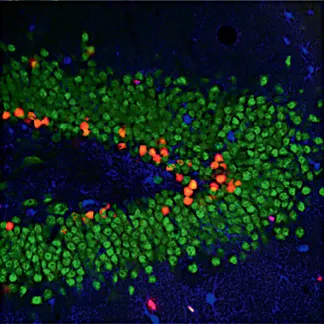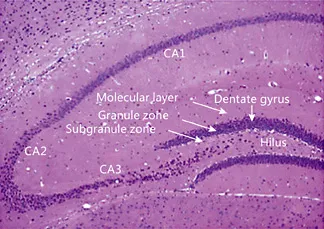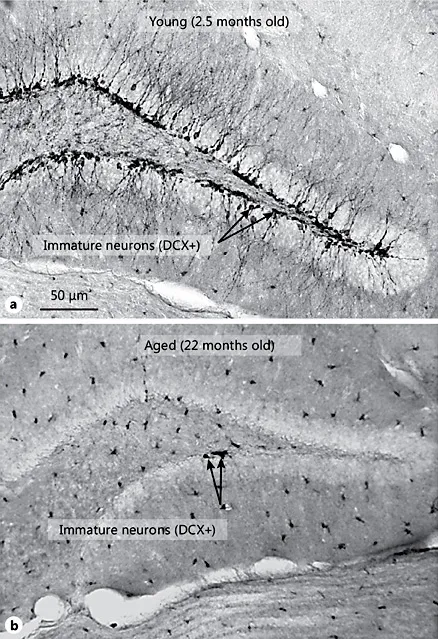![]()
Halaris A, Leonard BE (eds): Neuroprogression in Psychiatric Disorders.
Mod Trends Pharmacopsychiatry. Basel, Karger, 2017, vol 31, pp 124–151 (DOI: 10.1159/000470812)
______________________
The Contribution of Adult Hippocampal Neurogenesis to the Progression of Psychiatric Disorders
Rachel A. Kohmana · Justin S. Rhodesb
aDepartment of Psychology, University of North Carolina Wilmington, Wilmington, NC, and bDepartment of Psychology, The Beckman Institute, University of Illinois, Urbana, IL, USA
______________________
Abstract
New neurons are continuously formed in the adult hippocampus of the human, nonhuman primate, and rodent throughout life though rates of neurogenesis precipitously decline with age to near zero levels at the end of the natural life span. Since its discovery in the 1960s, a large number of studies have documented numerous environmental and genetic factors which regulate adult neurogenesis. Chief among the positive regulators of neurogenesis are exercise and antidepressant drugs. Chief among the negative regulators of neurogenesis besides age are stress and inflammation. To the extent that many psychiatric disorders are comorbid with or causally related to stress and inflammation, decreased neurogenesis could be a partial contributor to the pathophysiology of the disorders. However, the functional significance of new neurons in behavior has yet to be established and is currently a hotly debated topic. Therefore, it is not clear whether changes in neurogenesis that occur alongside psychiatric illnesses are a cause or a consequence of the mediating factors such as stress, drug abuse, and inflammation, which are complexly involved in the disorders. It will be important moving forward to use modern technologies capable of instantaneously inactivating cohorts of new neurons to test their functional significance in behavior and the etiology of mental illnesses.
© 2017 S. Karger AG, Basel
Introduction
In this chapter, we consider the recent literature on the role of adult hippocampal neurogenesis (and lack thereof) in psychiatric illnesses. We first carefully define adult hippocampal neurogenesis and briefly review the current understanding of the functional significance of adult neurogenesis in behavior, a topic that is still under considerable debate. Followed by a brief review of the positive regulators of neurogenesis, the majority of the chapter emphasizes known risk factors of psychiatric illnesses that are confirmed to negatively regulate neurogenesis, including the effects of stress and inflammation. Lastly, we discuss the evidence in support of a role of adult hippocampal neurogenesis in schizophrenia and major depressive disorder as well as currently employed pharmacological treatments.
Adult Hippocampal Neurogenesis
Prior to the 1960s, it was generally thought that new neurons were not formed in the adult human brain [1]. Instead, it was thought that a person was born with all the neurons they would ever have and that all one could do as an adult was to lose neurons through environmental exposures and experiences [2]. However, it was not until the late 1980s to early 1990s when immunohistochemical technologies became available that convinced the entire scientific community that neurogenesis continues to occur in certain regions of the adult human brain throughout life (Fig. 1) [3]. Remarkably, in two regions of the brain, levels of neurogenesis can be quite high, such as in the hippocampus and the olfactory bulb [4]. Because of the crucial importance of the hippocampus in learning and memory, since the 1990s, much attention has been devoted to understanding the regulatory factors and functional significance of adult hippocampal neurogenesis. Therefore, in the remainder of this chapter when we use the term adult neurogenesis, we are referring to adult hippocampal neurogenesis unless otherwise noted.
The mammalian hippocampus is crucially important for associative learning [5]. This has been demonstrated extensively in human and animal lesion and functional imaging studies [6, 7]. The hippocampus is well positioned for a function in forming associations between different types of stimuli because it is the first place in the brain that receives information from all the sensory modalities [5]. The information first converges on a region of the hippocampus known as the dentate gyrus. The granule neurons of the dentate gyrus receive the information through their dendrites which contact terminals of afferent entorhinal cortical neurons (Fig. 2). The entorhinal cortical neurons carry processed sensory information that is segregated by modality.
Fig. 1. Measuring adult hippocampal neurogenesis. Photograph of a section through the granule cell layer of the dentate gyrus of the hippocampus of a mouse, triple fluorescent stained to visualize adult neurogenesis. The mouse was given an intraperitoneal injection of bromodeoxyuridine (BrdU) to label dividing cells approximately 1 month before the mouse was euthanized. The brain was then sectioned and stained using immunohistochemistry. The red fluorescent label was conjugated to an antibody against BrdU and, therefore, detects newly formed cells approximately 1 month old. The green label was conjugated to an antibody against neuronal nuclear protein, to detect mature neurons. The blue label was conjugated to an antibody against S100β to detect mature astrocytes. The cells in the inside layer adjacent to the hilus that are yellow/orange have both the BrdU indicating newly formed cell that subsequently differentiated into a mature neuron, an episode of neurogenesis. A few cells outside the granule layer labeled purple indicate newly formed astrocytes.
One of the features of the mapping from the entorhinal cortex to the dentate that is thought to be critical for its function as an integrator of information is that the granule neurons are far more numerous than the relatively sparse inputs from the entorhinal cortex [8]. This feature of few to many mapping is thought to enable unique representations even for very similar contexts or pairings of multiple related stimuli. This ability to distinguish subtle differences between similar contexts is referred to as pattern separation. The idea that the granule neurons of the dentate gyrus play a crucial role in pattern separation has recently received a great deal of attention [9–12]. The granule neurons, primarily excitatory and glutamatergic, project to the CA3 region of the hippocampus, a region of the hippocampus that has been widely studied for its role in long-term potentiation and integration of the sensory information into unique representations [5].
Fig. 2. Anatomy of the hippocampus. The hippocampus is composed of the dentate gyrus, CA1–CA3 fields. Information flowing into the hippocampus makes first contact on dendrites of granule neurons of the dentate gyrus which project into the molecular layer. Axons of granule neurons project to CA3 through the hilus.
For the purposes of this review, an episode of adult hippocampal neurogenesis will be defined as an event in which a cell is born in the subgranule zone of an adult organism AND subsequently survives AND differentiates into a granule neuron AND functionally integrates into the hippocampal circuitry. The entire process from proliferation to integration is estimated to take approximately 4 weeks or longer [13]. The inside layer of the dentate gyrus adjacent to the hilus is referred to as the subgranule zone; it contains the stem cells and progenitor cells that asymmetrically divide to produce one daughter cell that has the potential to differentiate into a neuron or glial cell while the other cell retains its regenerative capacity for additional cycles of asymmetric division (Fig. 2). Eventually, the progenitor cell differentiates into an astrocyte [14]. A majority of the newly formed daughter cells do not survive [15]. Of the remaining cells that survive, a majority differentiate into granule neurons (approximately 80–90%) [16]. As they mature, they move to the outer edges of the granule cell layer. Approximately, 10–15% of the surviving cells differentiate into astrocytes, and remaining cells differentiate into oligodendrocytes or remain undifferentiated for an extended period [17]. Using methods which label the cells in vivo (e.g., by expressing green fluorescent protein), it has been estimated that it takes approximately 3–4 weeks for a newly divided cell to differentiate into a functional neuron [13]. Because the process of adult hippocampal neurogenesis involves multiple steps, a treatment or factor can affect adult hippocampal neurogenesis by affecting any or multiple stages in the process. For example, a treatment might increase proliferation of dividing cells but have no influence on survival or vice versa. Alternatively, a treatment might have no influence on proliferation or survival but might increase differentiation and integration. In all cases, net neurogenesis would increase.
Neurogenesis across the Life Span
Perhaps the most crucial factor to consider when evaluating levels of adult hippocampal neurogenesis is the age of the animal at the time when the measurement was taken. Age is crucially important to consider when interpreting group differences in neurogenesis because even slight differences in age distribution will confound the response unless measures are taken to account for the effect of age using statistical methods (Fig. 3). Levels decrease dramatically from young adult to middle aged to aged, with barely detectable levels at the end of the life span [18–20]. This has important implications for understanding the functional significance of adult hippocampal neurogenesis because neurogenesis is at such low levels in aged relative to younger subjects, yet aged subjects’ brains are still broadly functional. Further, neurogenesis would be predicted to play a differential role in psychiatric illnesses depending on the time point during development that the psychiatric illness presents itself.
Fig. 3. Adult hippocampal neurogenesis dramatically declines with age. Photographs of the granule layer of the dentate gyrus stained for the doublecortin (DCX) marker of immature neurons of a young adult (a) and an aged mouse (b).
Functional Significance of Adult Hippocampal Neurogenesis
Because of the large literature establishing the role of the hippocampus in learning and memory, it is often assumed that adult hippocampal neurogenesis serves a specific function in learning and memory. It is well established that new neurons are more excitable than older neurons and have lower thresholds for displaying long-term potentiation [13, 21, 22]. More...



